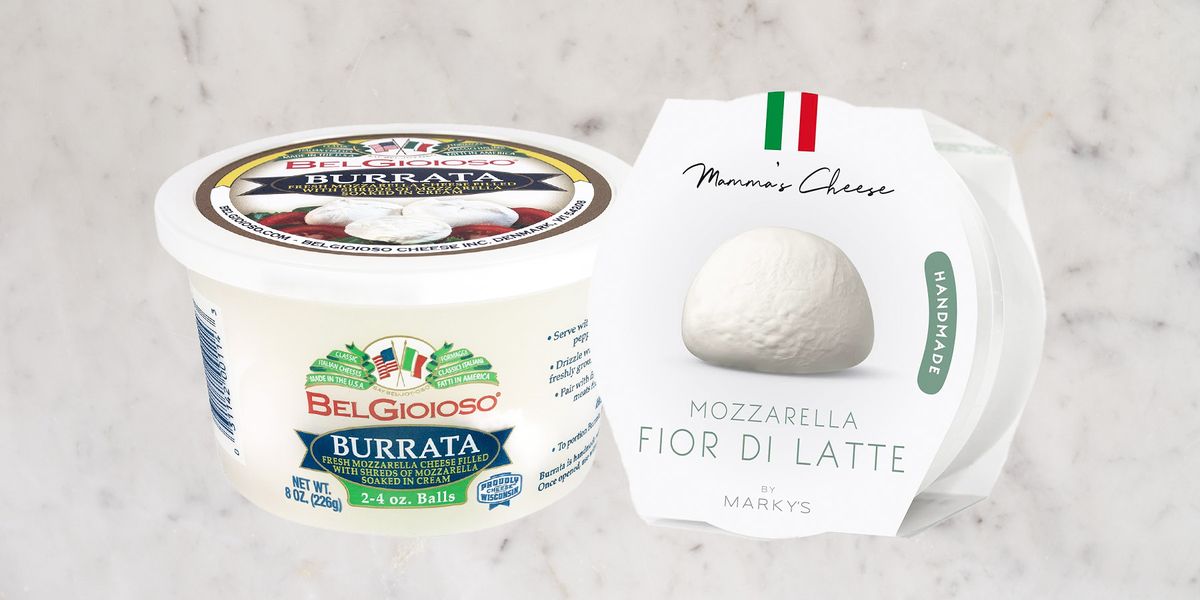
WHAT'S THE DIFFERENCE BETWEEN BURRATA & MOZZARELLA?
Burrata has been dominating restaurant menus for years. Whether you find it as the centerpiece of a salad, topping a plate of pasta, or just with a drizzle of olive oil and some bread, burrata is the creamy darling of the cheese world.
Part of the ingredient’s charm is its soft and creamy center. But it also tastes mild enough to appeal to any kind of cheese lover—just like its sister, mozzarella. That makes sense, because burrata is closely related to the mozzarella you see in a caprese salad or Neapolitan pizza.
As similar as they may be, there are several characteristics that distinguish the two cheeses.
How Are Burrata And Mozzarella Similar?
Both cheeses originally hail from southern Italy. American mozzarella is typically made from cow’s milk, but the Italian tradition was developed using milk from both cows and water buffalos. Cheese made from the latter is slightly tangier, but packs in twice as much fat as its cow-based counterpart.
Regardless of the milk that’s being used, mozzarella and burrata both begin like any other cheese does: with cheese curds. Cheesemakers start by separating the milk into curds and whey. Curds can be enjoyed as is, like the ones that top a poutine, or they can be molded and aged to create other cheeses.
But for mozzarella and burrata, the curds take a hot bath (in either water or the leftover whey). As they warm up, the curds go from squeaky to stringy. Cheesemakers take those warm pieces of whey and form them into balls. Neither burrata nor mozzarella undergo long aging periods, so they taste fresher and less assertive than other types of cheese.
How Are Burrata And Mozzarella Different?
Once the cheese curds are heated and stretched, the process of making mozzarella and burrata diverge. Mozzarella can be shaped into balls and sold as is, either shrink-wrapped or stored in brine to maintain the moisture. But it can also undergo further processing.
Mozzarella, especially in the U.S., is often ripened slightly and dehydrated in a controlled environment to remove some of the water. The result is low-moisture mozzarella, the same you see in large blocks, shreds, or tubes of string cheese at the grocery store. With less water (between 45-52%, compared to 60% in fresh mozzarella), low-moisture varieties have a longer shelf life and are better for melting on top of pizza.
Burrata, on the other hand, is always served fresh. Its beauty is in its softness and creaminess, so you’ll never find low-moisture versions. Instead of being shaped into a solid ball, cheesemakers use the curds to create a hollow pouch.
The pouch is then filled with something called stracciatella. The product, named after the Italian word “straccia,” which means rag or shred, is made from jagged scraps of mozzarella mixed with fresh cream. It can be enjoyed on its own, but Americans will most commonly see it in the center of a ball of burrata.
Can You Use Burrata And Mozzarella Interchangeably?
The short answer is: sometimes. Ultimately, it depends on the recipe you’re making and the original purpose of the cheese. But there are a few rules of thumb that you can keep in mind.
First of all, you shouldn't ever swap burrata for low moisture mozzarella, or vice versa. The wildly different water content of the two products means that they’re not interchangeable. Odds are that recipes using low-moisture mozzarella call for the ingredient for a reason—subbing in moist and creamy burrata will likely leave you with an unwanted soggy texture.
As for substituting burrata and fresh mozzarella, you need to rely on context clues and use your best judgement. Planning on using small pieces of cheese for individual appetizers, like an antipasto skewer? Runny burrata likely isn’t going to work. But serving a large caprese to share? Feel free to use the two cheeses interchangeably.
Both mozzarella and burrata lend a mild creaminess, but to different degrees. Burrata is naturally richer and runnier, which means you should only use it when you’re comfortable with cheese taking center stage in your dish. In any other case where you’d prefer dairy to play a supporting role, you’re better off using plain mozzarella.
2024-06-25T19:51:10Z dg43tfdfdgfd